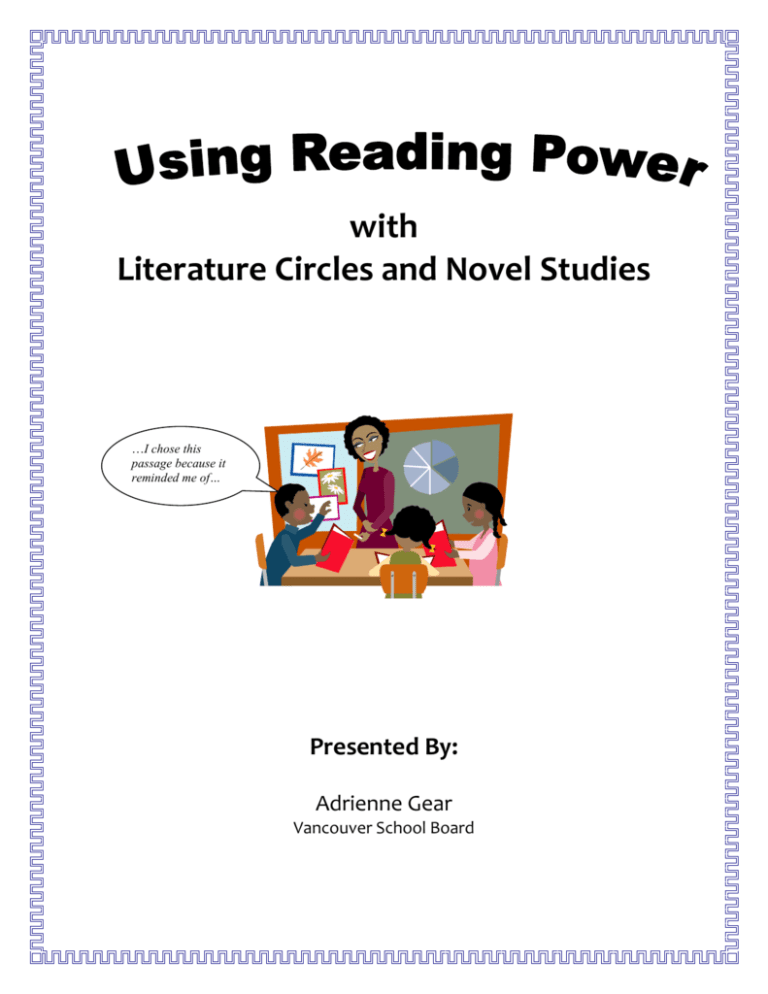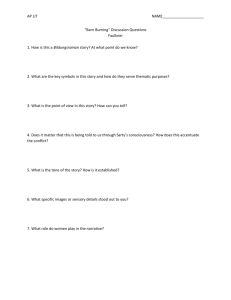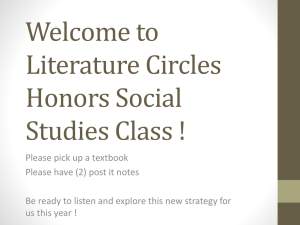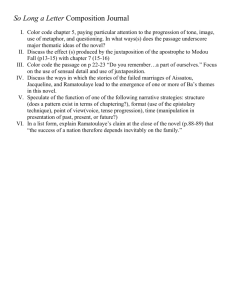with Literature Circles and Novel Studies Presented By: Adrienne
advertisement

with Literature Circles and Novel Studies …I chose this passage because it reminded me of… Presented By: Adrienne Gear Vancouver School Board Integrating Reading Power into Your Novel Study and/or Literature Circles Adrienne Gear GOALS: • • • • Students have a more meaningful, interactive and enjoyable reading experience Students gain a deeper understanding of the book than if they had answered comprehension questions after every chapter After students are “trained” for independence” they will work independently while each Lit. circles are in progress Students are “gradually released” from my guidance during Lit. Circle discussions and can continue on their own IMPORTANT: • This is an opportunity for students to APPLY their understanding of the Reading Power strategies to the books they are reading THEREFORE: direct instruction in the Reading Power strategies FIRST is critical for success. PLANNING MY YEAR: Suggestion • • • TERM ONE: - Reading Power strategies are taught (or reviewed) using picture books TERM TWO: - Whole class novel – teacher guides students through format - Students still meet in small groups weekly, but all are discussing the same book - Teacher provides “mini lessons” for each additional activity TERM THREE: - Lit. Circles – students are grouped according to reading level, each group has a different book - Students work more independently because they are more familiar with the format and activities GETTING STARTED: • • • Group your class into three or four ability groups, based on reading assessment (R.A.D., D.A.R.T., D.R.A., Whole Class Reading Assessment, etc.) If possible, arrange with your resource teacher or T.L. to be involved (take one of your groups) Block off two 1hr. Blocks in your weekly schedule for Lit. Circle • • Select appropriate leveled novel for each group (read them!) Divide each novel into 6-8 (depending on how long you wish to spend) even sections (note page numbers) to ensure everyone finishes their book at the same time. ie: Lemonade War Week 1 – pages 3-15 Week 2 - pages 16-28 Week 3 – pages 29-36. LESSON One • Each student receives Lit. Circle booklet, small stack of post-it notes. • Teacher explains format of literature circles and explains expectations: Weekly assignments for students: 1) Read assigned pages of your novel 2) Prepare passage with sticky note that you will be sharing during Lit. Circle discussion time. 3) Complete a “thinking page” 4) Add any new words to vocabulary page 5) Work to complete one additional activity per week Assessment will be based on: 1) Weekly written work and Lit. Circle booklets (teacher marks) 2) Preparation and discussion during Lit. Circles (teacher keeps track of student progress on Lit. Circle Discussion Record) • Students receive their novels and complete page one of booklet: Question/ Prediction page OTHER Lit. Circle ACTIVITIES (mini lessons) • • • • • Characters I Will Meet – as new characters are introduced, students record their names, who they are, a picture and personality traits describing them. Character VENN – students compare themselves with the main character. Words should include both descriptors of themselves – ie: girl, student, only child, plays hockey AND personality traits – ie: brave, funny, kind, determined. Setting Map – students draw, label and color a map of the setting of the book. This should be done as a bird’s eye view and include all the places mentioned in the book. Photo Album – “You are the illustrator of this book. Choose 5 moments/events/images from this book that you would like to capture. Draw and color your illustrations and include a caption and page number” TRANSFORMING My Thinking – students complete this sheet. They will need to have had some previous background and practice in this strategy. • • • Remember to include how their thinking has changed now that they have finished reading the book. Letter to the Author – students write a letter to the author. The letter should include – an introductory paragraph introducing themselves to the author, their response/reaction to the book, the parts they liked and why, their personal connections, Vocabulary page – students record any new words they encounter during reading. Definitions and sentences for each word should be included. Title Page – create a front cover for their package. Include the title of the novel (block or 3-d lettering is encouraged), THEIR name, a border and some colored coloured illustrations. Remind them they are not to copy the pictures from the original cover of the book. REMEMBER: • Don’t expect to implement Literature Circles tomorrow! • Set your goal for beginning this approach for the next reporting term. • Take things from this session and use them with what is already working for you. RECOMMENDED RESOURCES: Harvey Daniels – Literature Circles: Voice and Choice in Book Clubs and Reading Groups (2001) Mini Lessons for Literature Circles (2004) Grand Conversations, Thoughtful Responses: A Unique Approach to Literature Circles – Faye Brownlie Portage and Main, 2005 Lit. Circle Discussion Record Student: Date: NOVEL: ______________________ TOTAL: Passage Selection: Individual Sharing: Group Participation: Comments: Student: Date: TOTAL: Passage Selection: Individual Sharing: Group Participation: Comments: Student: Date: Passage Selection: Individual Sharing: Group Participation: Comments: TOTAL: LIT CIRCLE REPORT CARD COMMENTS: 1. Comes to novel study prepared with a passage to share and thoughtfully and readily contributes to the group discussions. 2. Demonstrates application of a variety of comprehension strategies while reading his/her novel. 3. Has demonstrated an ability to summarize (re-tell) what happened in the novel, as well as interpret and infer deeper meaning.







